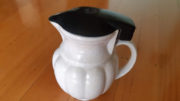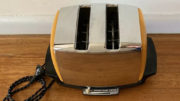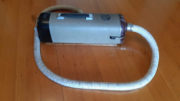 The invention of the light bulb is sometimes attributed to Thomas Alva Edison, but today it is well-known that Heinrich Goebel built functional bulbs three decades earlier. Many others also contributed to the development of a practical device for the production of electrically generated lighting.
The invention of the light bulb is sometimes attributed to Thomas Alva Edison, but today it is well-known that Heinrich Goebel built functional bulbs three decades earlier. Many others also contributed to the development of a practical device for the production of electrically generated lighting.
In 1801 Sir Humphry Davy, an English chemist, made platinum strips glow by passing an electric current through them, but the strips evaporated too quickly to make a useful lamp. In 1809 he created the first arc lamp, which he demonstrated to the Royal Institution of Great Britain in 1810, by creating a small but blinding arc between two charcoal rods connected to a battery.
In 1840 a British scientist Warren De la Rue enclosed a platinum coil in an evacuated tube and passed an electric current through it. The design was based on the concept that the high melting point of platinum would allow it to operate at high temperatures and that the evacuated chamber would contain less gas particles to react with the platinum, improving its longevity. Although it was an efficient design, the cost of the platinum made it impractical for commercial use.
In 1835 James Bowman Lindsay demonstrated a constant electric light at a public meeting in Dundee. He stated that he could “read a book at a distance of one and a half foot”. However having perfected the device, to his own satisfaction, he turned to the problem of wireless telegraphy and did not develop the electric light any further.
In 1841 Frederick de Moleyns of England was granted the first patent for an incandescent lamp, with a design using powdered charcoal heated between two platinum wires.
In 1854, the German inventor Heinrich Goebel developed the first ‘modern’ light bulb: a carbonized bamboo filament, in a vacuum bottle to prevent oxidation. In the following five years he developed what many call the first practical light bulb. His lamps lasted for up to 400 hours. He did not immediately apply for a patent, but his priority was established in 1893.
Joseph Wilson Swan(1828-1914) was a physicist and chemist born in Sunderland, England. In 1850 he began working with carbonized paper filaments in an evacuated glass bulb. By 1860 he was able to demonstrate a working device but lack of a good vacuum and an adequate supply of electricity resulted in a short lifetime for the bulb and inefficient light. By the mid-1870s better pumps became available, and Swan returned to his experiments. Swan received a British patent for his device in 1878. Swan reported success to the Newcastle Chemical Society and at a lecture in Newcastle in February 1879 he demonstrated a working lamp that utilized a carbon fibre filament. The most significant feature of Swan’s lamp was that there was little residual oxygen in the vacuum tube to ignite the filament, thus allowing the filament to glow almost white-hot without catching fire. From this year he began installing light bulbs in homes and landmarks in England and by the early 1880s had started his own company.
Across the Atlantic, parallel developments were also taking place. On July 24, 1874 a Canadian patent was filed for the Woodward and Evan’s Light by a Toronto medical electrician named Henry Woodward and a colleague Mathew Evans, who was described in the patent as a “Gentleman” but in reality a hotel keeper. They built their lamp with a shaped rod of carbon held between electrodes in an glass bulb filled with nitrogen. Woodward and Evans found it impossible to raise financial support for the development of their invention and in 1875 Woodward sold a share of their Canadian patent to Thomas Edison.
Edison purchased the Woodward and Evans patent and had a team of developers search for an alternative filament material. Eventually he used a carbon filament that burned for forty hours (first successful test was on October 21, 1879; it lasted 13 1/2 hours). Edison continued to improve their design. By 1880 he had a device that could last for over 1200 hours using a bamboo-derived filament, longer than the 400 hours of Heinrich Goebel’s earlier light bulb.
In January 1882, Lewis Latimer received a patent for the “Process of Manufacturing Carbons,” an improved method for the production of light-bulb filaments which yielded longer lasting bulbs than Edison’s technique.
In Britain, Swan took Edison to court for patent infringement. Edison lost and as part of the settlement, Edison was forced to take Swan in as a partner in his British electric works. The company was called the Edison and Swan United Electric Company. Eventually, Edison acquired all of Swan’s interest in the company. Swan sold his U.S. patent rights to the Brush Electric Company in June 1882.
Edison and his team did not find a commercially workable filament (bamboo) until more than 6 months after Edison filed the patent application. The weak and short lived (40-150 hours) carbon filament was eventually superseded by the tungsten filament. In 1903 Willis Whitnew invented a filament that would not make the inside of a lightbulb turn dark. It was a metal-coated carbon filament. In 1906, the General Electric Company were the first to patent a method of making tungsten filaments for use in incandescent lightbulbs. The filaments were costly, but by 1910 William David Coolidge (1873-1975) had invented an improved method of making tungsten filaments. The tungsten filament outlasted all other types of filaments and Coolidge made the costs practical




